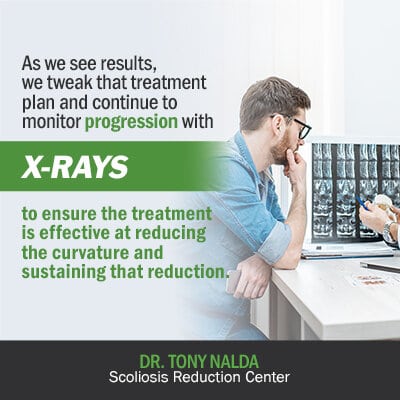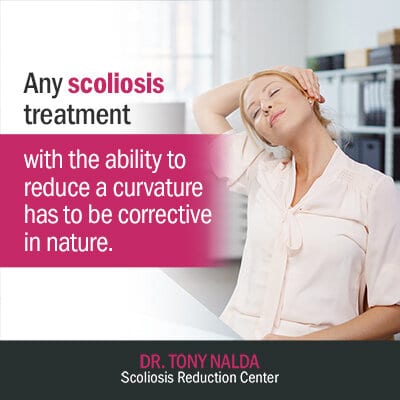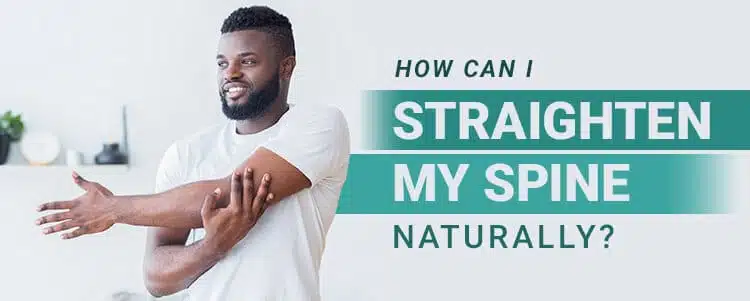As a supporter of alternative forms of scoliosis treatment, I clearly believe in the merits of a more natural approach; that being said, there is a big difference between a natural treatment plan designed by an experienced scoliosis specialist, or designing one yourself and treating your condition at home. While natural techniques such as exercise, therapy, bracing, and chiropractic can be hugely successful at reducing scoliosis, they need to be integrated and applied by a scoliosis specialist to achieve their full treatment potential.
When someone asks me about natural treatment for scoliosis, I assume they mean forms that don’t include spinal-fusion surgery. I’m all for anything that helps patients avoid the risks, costs, and invasiveness of this traditional approach, but what patients need to be aware of is that any treatment plan needs to be designed and applied by a specialist. First, let’s talk about the approaches involved in a more natural approach, and then we’ll talk about the cons of attempting some of these without professional guidance.
The Natural Treatment Approach to Scoliosis
When someone is looking for a natural way to straighten their spine, I first have to say that scoliosis is progressive, meaning there’s no form of treatment that can 100-percent straighten the spine permanently.
What effective scoliosis treatment does is reduce the curvature as much as possible, but efforts need to be continued to sustain those results and monitor/manage the condition.
Here at the Scoliosis Reduction Center®, our approach is natural, effective, and sustainable, and there are four main tools we use to achieve a structural change to our patients’ spines: scoliosis-specific exercises, chiropractic care, therapy, and corrective bracing.

Based on the characteristics of each patient and their condition, we design a treatment plan with different proportions of each discipline. This addresses the age of the patient, the size of their curvature, the location of their curvature, and any symptoms they are experiencing.
As we see results, we tweak that treatment plan and continue to monitor progression with X-rays to ensure the treatment is effective at reducing the curvature and sustaining that reduction.
Let’s take a closer look at the four main treatment tools we use.
Scoliosis-Specific Exercises
When it comes to a more natural approach to treating a patient’s scoliosis, exercises can be a big part of that plan. General exercise won’t help to reduce a curve, but corrective scoliosis-specific exercises that are customized to the individual patient’s condition can be a valuable tool.
Isometric Exercises
Isometric exercises are specifically effective for people with scoliosis and are performed without motion and against resistance.
Push-and-hold movements are a large component as they have the ability to strengthen the body’s core postural muscles and address the asymmetry that scoliosis causes, enabling the muscles to better support the spine.
Weight-Bearing Exercises
Weight-bearing exercise, such as uneven spinal weighting, when designed correctly, can be very effective in getting the spine to move in the direction we want. By influencing the spine externally with techniques such as uneven spinal weighting, we are prompting an internal response.
This is what we want: rather than pushing the spine into a healthier position, we are manipulating external forces to get the spine to respond and naturally move into a healthier position.
With successful uneven spinal weighting, we are manipulating the mechanoreceptors in the joints to change the messages they are sending to the brain, which in turn changes the messages the brain is sending to the body.
These new messages tell the body to hold its new position, and this can help reduce and stabilize scoliosis.
Chiropractic Care
Here at the Center, our chiropractic care is corrective and scoliosis-specific. While general chiropractic hasn’t had a lot of benefit for scoliosis patients, our technique differs because it was designed specifically to address the issues that scoliosis causes.
Our approach doesn’t just differ in frequency and treatment duration, but also in the nature of the actual chiropractic adjustments used. Our approach facilitates the spine’s ability to support itself, rather than merely pushing and holding it in a better position.
Our chiropractic care works to strengthen the spine so that it naturally moves into a healthier position, stabilizing the scoliosis and supporting it.
Scoliosis-Specific Therapy
With scoliosis-specific therapy, the goal is to mobilize the spine in a corrective position. This can involve a variety of techniques such as traction, de-rotation, and vibration. With state-of-the-art equipment specifically designed to impact scoliosis, each aspect of treatment works to complement and work with other forms of treatment being applied.
When designed and applied correctly, scoliosis-specific therapy can help us address the rigidity in the spine that scoliosis is known to cause, and by addressing this and increasing flexibility, the spine is more malleable and responsive to treatment.
This integrative approach is key to successfully treating and managing scoliosis.
Corrective Bracing
Bracing has always had a place in scoliosis treatment, but we have also come a long way in our understanding and application of this form of treatment.
Traditional bracing is about merely stopping progression, but not actually correcting the structural deformity of the scoliosis itself.
Here at the Center, we use corrective bracing, such as the customized ScoliBrace, and the goal is to achieve a curvature reduction by correcting the structural misalignment of the spine. This is the big difference between holding the spine with traditional bracing, or pushing to correct it and facilitating its ability to support itself.
Now that we’ve addressed some of the actual components of natural treatment for scoliosis, I would like to address the choice that some patients make to design their own natural treatment plan and apply it at home.
Why You Need a Scoliosis Specialist on Your Side
While I commend people who are proactive with their health and attempt to take control on their own, when it comes to complex progressive conditions like scoliosis, this can cause a number of problems.

First of all, as X-rays play a hugely important role in diagnosing and monitoring the condition, unless a person has the ability to do this at home, any treatment approach is going to fall short.
Any scoliosis treatment with the ability to reduce a curvature has to be corrective in nature. In order to determine that an aspect of treatment is working, the spine has to be monitored during the treatment application to see its response.
Whether it’s exercise, therapy, chiropractic care, or bracing, if a person is attempting these on their own with no way of actually seeing how their spine is responding, treatment efficacy can’t be determined and monitored.
A large part of successful scoliosis treatment is tweaking that plan as we see how the spine is responding. We might think it needs a little more of this, or a little less of that, or an increase or decrease in treatment intensity.
Through X-rays or objective measures, practitioners have to monitor the response of the spine to ensure the curvature is actively being reduced.
While it could be possible to straighten a spine naturally without surgery, it would take an integrative approach designed and monitored by a specialist.
There can also be an emotional component of self-treatment that comes into play, and often the patients I see after years of attempting to treat their condition themselves are the most difficult to work with.
Limited Bandwidth for Patients
When I say there’s a limited bandwidth for patients, I’m referring to the emotional component of scoliosis treatment.
What I’ve seen a lot of are patients who have attempted to mix their own components of treatment and integrate their own approach from home. What happens is these patients work at it for years and then come in to see me because their scoliosis either doesn’t seem to have improved or has gotten significantly worse.
Often, these patients have used a variety of forms of exercise, but not scoliosis-specific ones. Not only do exercises done from home have to be scoliosis-specific, they also have to be customized to the individual patient’s condition; only a specialist with access to years of experience and X-rays for monitoring can truly determine this.
These patients have worked intensely from home for years only to find out their curvature has progressed significantly. Now, what happens is they have lost a lot of their intensity to reduce their curve and have wasted valuable treatment time spinning their wheels; they are burnt out and discouraged.
In the chiropractic world, this is akin to people saying, “Well, chiropractic doesn’t work because I’ve cracked my own neck and nothing has improved.”
While some of the components that these patients implemented at home could be right, if they’re not integrated perfectly and monitored effectively, they are likely to end up wishing they had sought the help of a specialist from the get-go; had they done that, they would have seen actual results over the years and now be working on maintenance, rather than starting from scratch with the emotional strain of discouragement.
Conclusion
For people asking how they can straighten their spine naturally, I’m happy they are looking for alternative forms of treatment that help them avoid spinal-fusion surgery. What concerns me are those people who think ‘natural’ means treating their condition at home and mixing that treatment-cocktail on their own.
While they may be able to seek out some effective exercises or implement a healthy scoliosis-friendly diet on their own, no amount of research or at-home care can replace the expertise, monitoring ability, and customizability that a scoliosis specialist brings to the table.
Through our combination of scoliosis-specific exercises, chiropractic care, therapy, and corrective bracing, the Scoliosis Reduction Center® offers each and every patient a fully-customized experience with access to multiple disciplines and state-of-the-art treatment equipment.
When it comes to a progressive condition like scoliosis, you don’t want to waste valuable treatment time spinning your wheels at home. Seek out the help of a specialist who can diagnose your condition, monitor it effectively, and work with you to design a comprehensive treatment plan capable of reducing your condition and sustaining those results.





